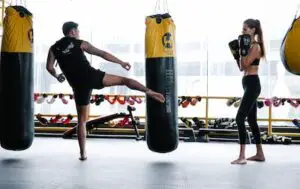Capoeira, the dynamic Afro-Brazilian martial art, is renowned for its blend of acrobatics, dance, and self-defense. Central to Capoeira is the ability to evade and move strategically, but even the most skilled practitioners may find themselves in a situation where taking a punch becomes necessary. Developing the skill to absorb impact effectively is crucial for Capoeiristas, allowing them to maintain their balance, flow, and counter-attacking abilities. In this comprehensive guide, we will explore essential techniques and training tips to help you master the art of taking a punch in Capoeira. By understanding proper body mechanics, improving reflexes, strengthening your core, and cultivating mental resilience, you can elevate your Capoeira performance while minimizing the impact of an opponent’s strikes.
Why is learning to take a punch important in Capoeira?
Learning to take a punch is fundamental in Capoeira for several reasons. Firstly, Capoeira is a martial art that emphasizes fluidity and continuity of movement. By developing the ability to absorb punches, Capoeiristas can seamlessly transition between defensive and offensive maneuvers, maintaining the grace and agility that define the art form. Secondly, understanding how to take a punch enhances a practitioner’s overall self-defense skills. While evasion is paramount, there may be situations where evasion alone is insufficient, and taking a punch becomes necessary. By learning to absorb impact effectively, Capoeiristas can minimize injury and quickly recover, allowing them to retaliate or escape as needed. Additionally, mastering the art of taking a punch instills confidence and mental resilience, enabling practitioners to remain composed and focused in combat scenarios.
Understanding body mechanics for effective impact absorption
Proper body mechanics play a crucial role in minimizing the impact of a punch in Capoeira. By maintaining optimal body alignment, distributing weight correctly, and utilizing footwork strategically, practitioners can absorb the force of a strike more effectively. When taking a punch, it is essential to roll with the impact, allowing the body to move and redirect the energy, rather than resisting it directly. This technique helps to disperse the force across a larger area, reducing the risk of injury. Furthermore, using the momentum generated by the opponent’s strike can assist in maintaining balance and control.
Strengthening core muscles for improved resilience
A strong core is vital for absorbing punches in Capoeira. The core muscles, including the abdominal, oblique, and lower back muscles, provide stability and support to the body. Strengthening these muscles enhances a practitioner’s ability to brace for impact and effectively absorb punches. Exercises such as planks, Russian twists, leg raises, and medicine ball rotations target the core muscles and should be incorporated into regular training routines. Additionally, training with resistance bands or using instability tools like stability balls can further challenge and strengthen the core, preparing Capoeiristas for the impact they may encounter during training or sparring.
Improving reflexes and reaction time
Quick reflexes and a swift reaction time are essential attributes in Capoeira, especially when it comes to taking punches. By developing these skills, practitioners can effectively evade or minimize the impact of an opponent’s strike. Partner drills, such as punch-catching exercises, can significantly improve reflexes. These drills involve a partner throwing punches at controlled speeds, allowing the Capoeirista to practice their timing and defensive movements. Incorporating hand-eye coordination exercises, such as speed bag training or focus pad work, can also enhance reflexes and reaction time. Agility training, such as ladder drills, cone drills, and plyometric exercises, can improve overall coordination and responsiveness. By consistently engaging in these exercises, Capoeiristas can enhance their ability to anticipate and react swiftly to incoming strikes.
Practicing controlled sparring to simulate real combat situations
Sparring is an integral component of Capoeira training, providing practitioners with the opportunity to apply their skills in a controlled yet dynamic environment. Engaging in controlled sparring sessions allows Capoeiristas to develop the ability to take punches effectively while maintaining their flow and movement. It is important to establish clear communication and mutual respect with training partners to create a safe and conducive learning environment. Gradually increasing the intensity of sparring sessions helps simulate real combat situations and prepares practitioners for the unpredictability of a live fight. During sparring, Capoeiristas can practice their evasion techniques, footwork, and timing to avoid incoming punches while still maintaining an offensive mindset. Regularly engaging in controlled sparring sessions will build the necessary confidence, adaptability, and resilience required to effectively take punches in Capoeira.
Mental conditioning and overcoming fear
Taking a punch in Capoeira demands mental resilience and the ability to overcome fear. Fear and anxiety can hinder performance and reaction time, making it challenging to absorb punches effectively. Mental conditioning techniques can help practitioners manage their emotions during combat situations. Visualization exercises, where individuals mentally rehearse taking punches and responding calmly, can help desensitize the fear response and build confidence. Incorporating meditation into training routines aids in fostering focus, relaxation, and mental clarity. Positive self-talk is another effective technique to cultivate a confident mindset. By repeating affirmations or mantras that reinforce personal strength and resilience, Capoeiristas can overcome self-doubt and approach the art form with a strong and unwavering mindset.
Conclusion
Mastering the art of taking a punch in Capoeira requires a comprehensive approach encompassing physical and mental preparation. By understanding the principles of body mechanics, strengthening the core muscles, improving reflexes, engaging in controlled sparring, and developing mental resilience, Capoeiristas can enhance their ability to absorb punches effectively while maintaining their grace, flow, and counter-attacking prowess. Through consistent training and discipline, you can elevate your Capoeira skills and confidently navigate the challenges presented by combat situations. Remember, taking a punch is not a sign of defeat, but rather a testament to your resilience, adaptability, and dedication to the art of Capoeira.





